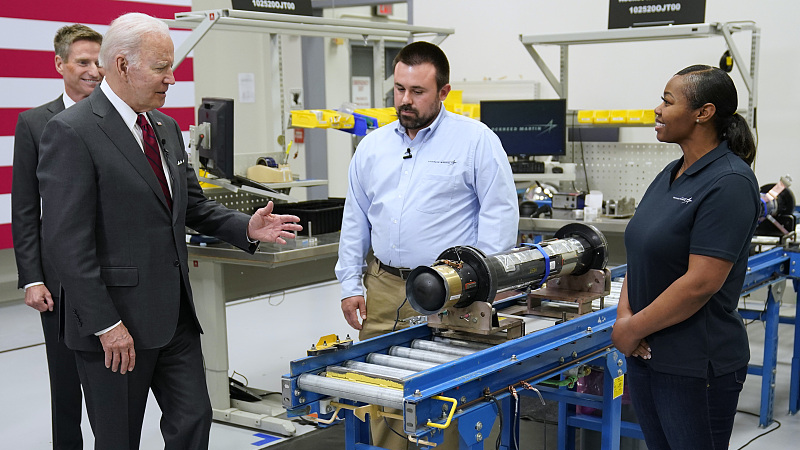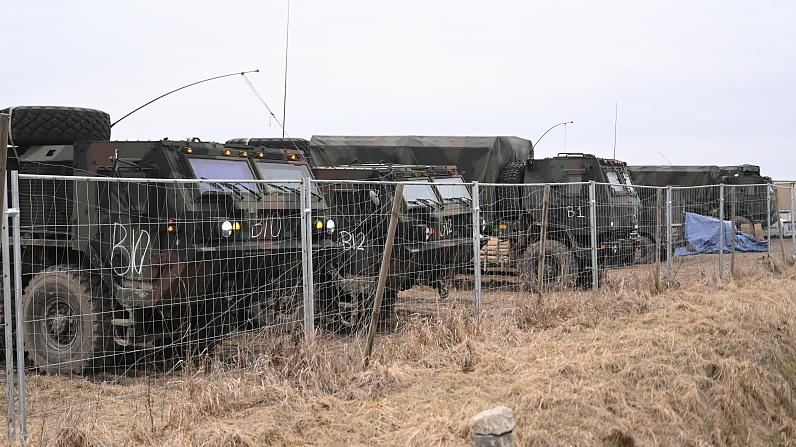
U.S. President Joe Biden visits the Lockheed Martin Pike County Operations facility where Javelin anti-tank missiles are manufactured, in Troy, Alabama, May 3, 2022. /VCG
U.S. President Joe Biden visits the Lockheed Martin Pike County Operations facility where Javelin anti-tank missiles are manufactured, in Troy, Alabama, May 3, 2022. /VCG
Editor's note: Andrew Korybko is a Moscow-based American political analyst. The article reflects the author's opinions and not necessarily those of CGTN.
U.S. President Joe Biden confirmed in an article for The New York Times on May 31 that his country will send "advanced rocket systems and munitions" to Ukraine "that will enable them to more precisely strike key targets on the battlefield in Ukraine." He also clarified that "We are not encouraging or enabling Ukraine to strike beyond its borders." This follows his statement to reporters the day prior on Monday that "We are not going to send to Ukraine rocket systems that can strike into Russia."
Separately, U.S. representative and ambassador to the UN Linda Thomas-Greenfield said on Tuesday that "We are not providing any weapons that will allow the Ukrainians to attack Russia from inside of Ukraine, and president [Joe] Biden has been very clear on that." This adds credence to reports from U.S. officials that the promised missiles will be medium-range ones capable of hitting targets up to 80 kilometers away instead of the long-range missiles that Kyiv requested for hitting targets up to 300 kilometers away.
Biden's missile shipments to Ukraine are a dangerous balancing act since even the medium-range ones that he's dispatching enable the recipient to strike beyond its borders into Russia. The American leader is attempting to please Kyiv without escalating tensions with Moscow, yet precision missiles of any range pose a threat to Russia. That's because there's no guarantee that Ukraine will follow Biden's guidelines. It might ultimately end up attacking its neighbor, with Washington powerless to stop it.
This development comes at a pivotal moment in what Russia describes as its special military operation in Ukraine intended to restore the integrity of its national security red lines there but which that country and its U.S.-led Western allies deem to be an unprovoked invasion. The Battle for Donbass is heating up, with most observers agreeing that the military dynamics on that front currently favor the Russian Armed Forces.

U.S. soldiers at the Zamosc-Mokre airfield currently being used by the U.S. Army's 82nd Airborne Division in Zamosc, Poland, close to the border with Ukraine, March 5, 2022. /VCG
U.S. soldiers at the Zamosc-Mokre airfield currently being used by the U.S. Army's 82nd Airborne Division in Zamosc, Poland, close to the border with Ukraine, March 5, 2022. /VCG
Russian Foreign Minister Sergey Lavrov recently reaffirmed that removing the Ukrainian military from that disputed region that Moscow nowadays recognizes as two independent republics is an "unconditional priority" for his country. Nobody is sure what will happen after that goal is achieved since Ukrainian President Volodymyr Zelenskyy repeatedly reminds everyone that his country will continue fighting until all Russian forces are removed from the territory that it considers its own.
This crucially includes Crimea, which Russia regards as having democratically reunified with it in spring 2014 following the Western-backed regime change in Ukraine at the time while Kyiv and most of the international community considers it to be an illegally annexed region. Since Moscow nevertheless treats the peninsula and its separately administered city of Sevastopol as an integral part of its territory, few doubt that it would protect its claims over them with full force if they're attacked by Ukraine.
It was precisely this scenario that Russian President Vladimir Putin warned about on February 24 when announcing his country's ongoing campaign in Ukraine. He ominously said that "the leading NATO countries … will undoubtedly try to bring war to Crimea just as they have done in Donbass … If we look at the sequence of events and the incoming reports, the showdown between Russia and these forces cannot be avoided. It is only a matter of time. They are getting ready and waiting for the right moment."
The danger therefore exists that Ukraine might use the medium-range precision missiles given to it by the U.S. on the pretext of defending Kyiv's claims to the disputed Donbass region to attack Russian-administered Crimea on the same basis even if Washington might not want this to happen. After all, U.S. officials told CNN in late April that they don't really know what happens to all the foreign arms that the West has been pouring into Ukraine since they've largely lost control over them.
It's for this reason why Biden's missile shipments to Ukraine are a dangerous balancing act. He doesn't want to be portrayed as having abandoned another American ally after his administration did exactly that to their Afghan ones in the face of the Taliban's nationwide offensive last summer, yet he also doesn't want to provoke Russia by escalating the crisis any more than his country already has. As a compromise, his administration decided to dispatch medium-range missiles instead of long-range ones.
The problem is that even these are capable of hitting Russia's universally recognized territory and might even put Russian-administered Crimea into reach if Kyiv makes substantial progress in its reportedly ongoing counteroffensive in Southern Ukraine. Both scenarios would be regarded by Russia as a major U.S.-backed escalation that could lead to an unpredictable reaction from Moscow. The end result is that Biden nevertheless created a dangerous escalatory scenario despite claiming that he didn't intend to.
(If you want to contribute and have specific expertise, please contact us at opinions@cgtn.com. Follow @thouse_opinions on Twitter to discover the latest commentaries in the CGTN Opinion Section.)

